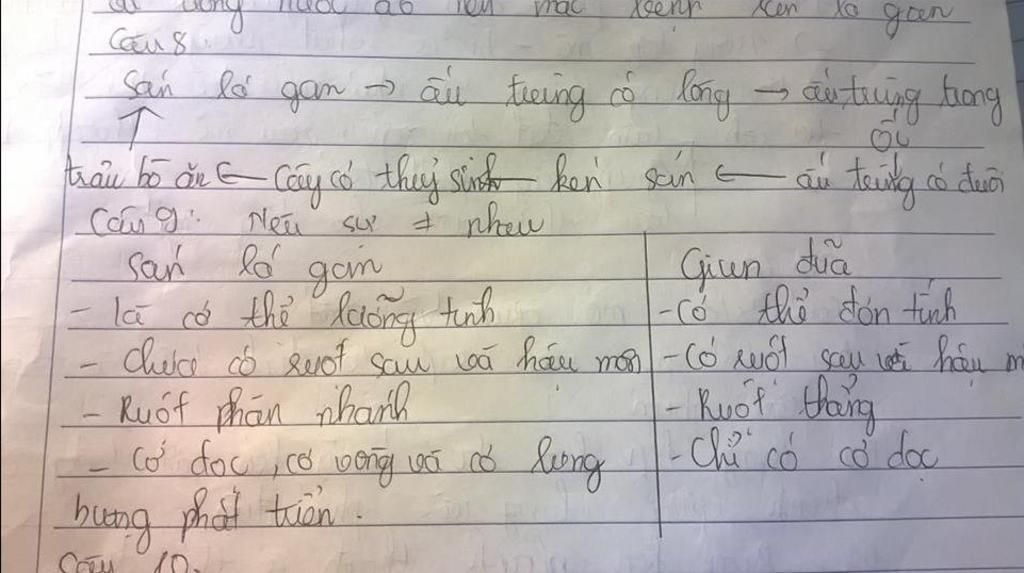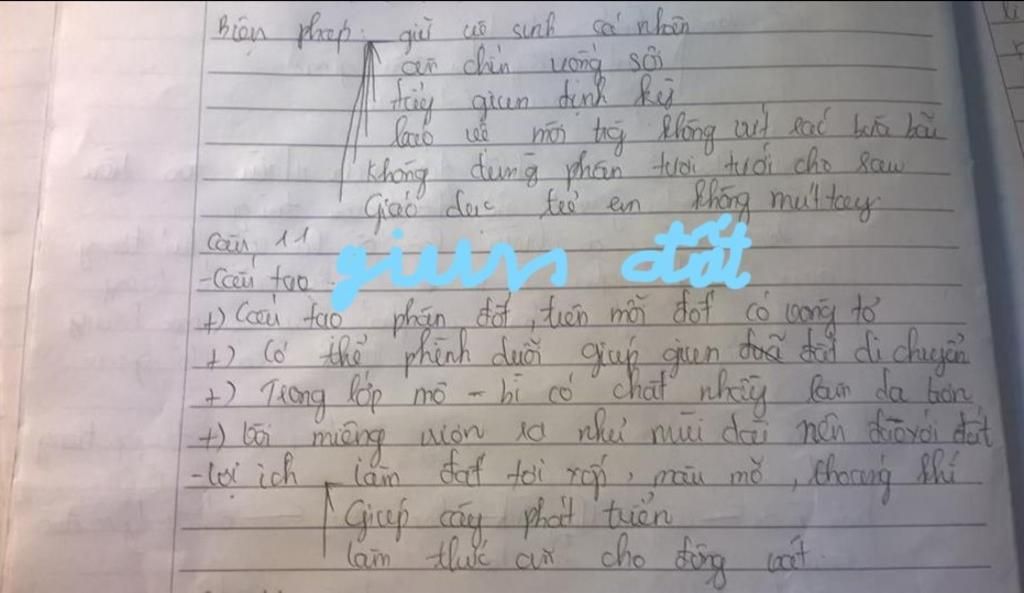Câu 1: Nêu tên, nơi sống của các động vật đã học, sắp xếp chúng vào các ngành động vật đã học Câu 2: Đặc điểm cấu tạo, sinh sản của trùng roi, trùng giày. Tại sao diệt bọ gậy liên quan đến phòng chống sốt rét, sốt xuất huyết ? Tại sao ở miền núi tỉ lệ nhiễm bệnh sốt rét, sốt xuất huyết lại cao? Nêu biện pháp phòng tránh nhiễm sốt xuất huyết, sốt rét? Câu 3: Đặc điểm chung và vai trò của ngành ruột khoang, cho ví dụ? Câu 4: Cấu tạo, dinh dưỡng, sinh sản của Thủy tức, sứa, san hô. Câu 5: Vẽ, mô tả vòng đời sán lá gan, giun đũa, giun kim. Nêu đặc điểm phát thiển thích nghi với phát tán nòi giống của chúng? Biện pháp phòng tránh nhiễm giun, sán kí sinh. Câu 6: Đặc điểm sán lá gan, giun đũa, giun đất, sán dây thích nghi với đời sống của chúng? Nêu được nơi kí sinh, con đường truyền bệnh của 1 số giun tròn, giun dẹp kí sính đã học.
2 câu trả lời
Giải thích các bước giải:
Câu 2:
Trùng roi : - Cấu tạo cơ thể trùng roi gồm có nhân, chất nguyên sinh có chứa các hạt diệp lục (khoảng 20 hạt), các hạt dự trừ và mắt
-Sinh sản vô tính theo cách phân đôi theo chiều dọc cơ thể
Trùng giày : - Có hình giống đế giày. Cơ thể có hình khối, không đối xứng, giống chiếc giày. Trùng di chuyển nhờ lông bơi.
- sinh sản theo hình thức vô tính, nhân đôi lên theo chiều ngang. Hoặc có thể sinh sản hữu tính bằng cách tiếp hợp
* Vì bọ gậy chính là con mỗi nhưg chưa tiến hoá vì vậy phải diệt luôn cả bỏ gậy nếu khôgn chúng sẽ biến thành muỗi và sẽ gây bệnh truyền nhiễm
* Ở miền núi tỉ lệ nhiễm bệnh nhiều hơn vì ở đó có những vũng nước mưa còn đọng lại sẽ làm chỗ sinh sản cho loài muỗi phát triển nên tỉ lệ gây bệnh rất nhiều
* Biện pháp để phòng tránh loại bệnh này là : - Di ngủ mắc màn
- Không để những chỗ lấy nước hở
- Loại bỏ hoàn toàn những vũng nước
- Cải thiện môi trường sống
Câu 3:
Đặc điểm chung của ngành ruột khoang :
+ Cơ thể đối xứng tỏa tròn. + Sống dị dưỡng.
+ Thành cơ thể gồm 2 lớp tế bào, giữa là tầng keo.khoang cơ thể rỗng (chưa phân hóa)
+ Ruột dạng túi. (gọi là ruột khoang) + Tấn công và tự vệ bằng tế bào ga
VD : Thuỷ tức có cơ thể đối xứng toả tròn
* Vai trò : - Đều có thể làm đò trang trí(đồ chơi)
- Làm thức ăn :))
- Làm vật liệu xây dựng :))
VD : San hô đá làm vật liệu xây dựng;....
Câu 4:
Thuỷ tức : - Dinh dưỡng: Dị dưỡng : bắt mồi bằng độc
- Sinh sản vô tính ; Sinh sản hữu tính ; Tái sinh
Sứa : - Dinh dưỡng : dị dưỡng ( bắt mồi bằng các xúc tu )
- Sinh sản hữu tính
San hô : - Sinh dưỡng : dị dưỡng ( bắt mồi bằng xúc tu và độc )
- sinh sản : hữu tính
Câu 6 + câu 5 + hình ảnh :
*Sán dây : - có thân, dài, được hợp thành bởi những đốt tương tự như nhau, nối với nhau tạo thành một dải dài.
- Tất cả các giai đoạn của vòng đời đều sống kí sinh.
- Giai đoạn trưởng thành kí sinh ở ống tiêu hoá của người, hoặc động vật có xương sống khác.
- Vòng đời : trải qua 3 giai đoạn - trứng, ấu trùng, và sán dây trưởng thành.


Đáp án:
Câu 1:
1,ngành động vật nguyên sinh: trùng giày, trùng roi, trùng biến hình, trùng sốt rét, trùng kiết lị,...
2,ngành ruột khoang: sứa, thủy tức, san hô, hải quỳ,...
3,ngành giun:
+ngành giun dẹp: sán lá gan, sán lông, sán lá máu, sán bã trầu, sán dây,...
+ngành giun tròn: giun đũa, giun kim, giun móc câu, giun rễ lúa,...
+ngành giun đốt: giun đất, giun đỏ, đỉa, rươi,...
ngành thân mềm: trai sông, ốc sên, mực, bạch tuộc, sò,...
ngành chân khớp:
+lớp giáp xác: tôm sông, mọt ẩm, con sun, rận nước, chân kiếm, cua đồng,...
+lớp hình nhện: nhện, bọ cạp, cái ghẻ, con ve bò,...
+lớp sâu bọ: châu chấu, bọ ngựa, mọt hại gỗ, ve sầu, bướm cải, ong mật, muỗi, ruồi,...
ngành động vật có xương sống:
+lớp cá: cá chép, cá trích, lươn, cá đuối, cá nhám,...
+lớp lưỡng cư: ếch đồng, ếch ương, cóc nhà, ếch giun,...
+lớp bò sát: thằn lằn bóng đuôi dài, rắn ráo, cá sấu, rùa,...
+lớp chim: chim bồ câu, đà điểu, chim cánh cụt, công,...
+lớp thú (lớp có vú): thỏ, thú mỏ vịt, kanguru, dơi,...

